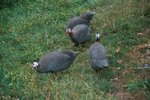While it's true that some guinea fowl breeders seem to possess a magical ability to tell the difference between males and females practically before the shells crack, most of us aren't so intuitive. But don't despair. After seven or eight weeks, physical, behavioral and aural clues will make it easy to tell the difference between the females (hens) and males (cocks).
Wait until the birds reach seven or eight weeks of age. Until then, any sound the babies (known as keets) make will range from a melodic cooing to an alarmed “Fwee! Fwee! Fwee!” that more than one owner has likened to the stabbing music in “Psycho.” Unnerving? Yes. Helpful? No.
Before you can figure out the difference between male and female calls, you must first learn the difference between a guinea alarm call and the “social networking” that guineas engage in to stay in touch while foraging. Both genders sound the same loud “Chi-Chi-Chi!” call when alarmed, and everything seems to alarm young guineas–-from an unfamiliar car to a falling leaf.
If you hear that sound, the obvious way to tell if the caller is male is to see if all the other guinea fowl are making it. If only one or a few of the birds are standing with their heads in the air, shrieking “Chi-Chi-Chi!” while their companions placidly scratch in the dirt, you’re looking at guinea cocks.
By the same token, if a guinea fowl calls out a half-inquiring, half-insistent noise that sounds like “Buckwheat! Buckwheat!” you’ll know you’re listening to a female. (Some people think the guineas hens sound as if they are poignantly calling “Come back! Come back!”)
Watch their gills. A week or so after their cries begin to settle themselves along gender lines, the tops and sides of the guinea fowls’ faces begin to change as well. The gills–the fleshy red parts called “wattles” on turkeys—are the most dramatic physical difference between guinea hens and guinea cocks. Male gills grow much longer than those of the female.
Note, too, that guinea cocks possess a slightly larger helmet–what we think of as a “comb” on regular roosters—than their female counterparts. Like the gills, the difference in helmets becomes apparent starting around three months of age.
While the helmet and gills will most likely be your best physical clues, when all else fails, check the legs. Male guineas boast longer legs.
If you’re watching guinea fowl from a distance, behavior often gives good clues as to the gender. Guinea cocks tend to be more protective, especially the “alpha” in the group. When there are two or more males around during mating season, you’ll often see them racing and chasing one another to gain dominance.
Take a walk during egg-laying season. If one of your guinea fowl goes missing, chances are it’s a hen on babysitting duty on the communal nest. While a guinea cock can sometimes be found hovering nearby, the “sitter” will always be female.
References
- Gardening with Guineas; Jeannette S. Ferguson; 1999
Resources
Writer Bio
Ellen Douglas has written on food, gardening, education and the arts since 1992. Douglas has worked as a staff reporter for the Lakeville Journal newspaper group. Previously, she served as a communication specialist in the nonprofit field. She received her Bachelor of Arts from the University of Connecticut.




